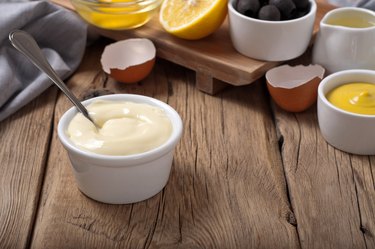
Emulsifiers keep the cream in your coffee and the dressing on your salad together. Emulsifiers such as lecithin stop oil and water from splitting. Lecithin occurs naturally. Wheatgerm and eggs contain lecithin. Not only does lecithin prevent the separation of certain foods, scientists believe that lecithin helps increase "good" HDL cholesterol. If you want to know why lecithin provides a healthy addition to your dinner table you need to understand how bubbles form.
Emulsifiers
Video of the Day
No matter how much you shake a mixture of oil and water it will soon separate. Oil and water repel each other. Even the smallest oil droplets soon clump together into large bubbles which float up to form a layer of oil. However, if something coats oil droplets to separate them from water they will float around for a long time, for example the oil in mayonnaise. The "something" you use to keep oil and water apart is called an emulsifier.
Video of the Day
Surface Active Agents
Imagine you are blowing bubbles. The air you breathed out floats away in a wrap of soapy water. Emulsifiers act just like that layer of soapy water. When oil, water and emulsifier are mixed together, the emulsifier rushes to the oil droplets and covers them. Because emulsifiers actively go straight to the surface of droplets they are called surface active agents or surfactants. According to the Boulder School in Condensed Matter, surfactants give emulsions even more stability by making the droplets repel each other.
Lecithin Structure
Lecithin is an emulsifier made up of about five smaller molecules. It has a backbone of glycerol that bonds up to three other molecules. Two of the bonded molecules are fatty acids -- these are hydrophobic. They give lecithin a structure similar to fats, or lipids. The third substance attached to glycerol is phosphoric acid that has an amino alcohol attached called choline. The phosphate/amino alcohol end of lecithin is hydrophilic. Shelly Schmidt, Ph.D., a professor in food science, explains that "emulsifiers are molecules that contain both a hydrophilic, water loving, and hydrophobic, water hating, portion." So, lecithin is a molecule with one end that is hydrophilic and another that is hydrophobic. Its chemical name is phosphatidylcholine.
Lecithin in Emulsions
Lecithin makes a good emulsifier because the hydrophobic end dissolves in oil droplets and the hydrophilic end dissolves in water. In emulsions the only place lecithin likes to be is at the edge of oil droplets with its hydrophobic end in the oil and the hydrophilic end in the water. If you think of a party balloon compared to soap bubbles you will understand that the balloon lasts a lot longer because the "bubble" is covered by the material of the balloon. Oil droplets in water are protected in the same way by lecithin so the emulsion stays stable for a long time.
Weight Loss
Gene Bruno of Huntington College of Health Sciences suggests that lecithin helps your body break down dietary and blood fats into small particles. This means fatty acids are more likely to be metabolized for energy rather than stored in your adipose tissue as fat. So, lecithin helps you burn off fat.